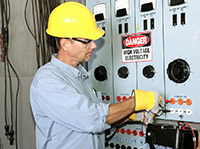February 2-8: National Burn Awareness Week
 Occupational burn injuries can be caused by fire, chemicals, heated objects or fluids, electricity, or other means. These burns can range from minor medical problems to life-threatening emergencies. Work-related burns account for 20-25% of all serious burns in the United States.1
Occupational burn injuries can be caused by fire, chemicals, heated objects or fluids, electricity, or other means. These burns can range from minor medical problems to life-threatening emergencies. Work-related burns account for 20-25% of all serious burns in the United States.1
Employers can help prevent and reduce the number of work-related burn injuries by establishing workplace safety programs and eliminating/reducing fire hazards and exposure to chemicals.
The Hierarchy of Control Principle:
Every workplace burn prevention strategy should incorporate all or some parts of the hierarchy of control principle2, which is used throughout the safety and health professional community to ensure that cost-effective hazard controls are utilized. There are four parts that comprise the hierarchy of control:
Engineering controls (eliminate or reduce exposure to a hazard through the use or substitution, such as replacing worn or out-of-date machines or materials, scheduling maintenance, etc.);
- Safeguard workers from burns from electrical wires and parts by ensuring they are insulated. An insulator (such as glass, rubber, and plastic) has high resistance to electric current and prevents shock, fires, and short circuits.
Administrative controls (update written safety policies, labeling hazards, promptly investigating work-relatedburn incidents);
- Post easy to follow burn treatment instructions next to fully stocked first aid kits in workplace kitchens, restrooms, and workshops.
Safe Work Practices (e.g., clear expectations, defined/approved  procedures);
procedures);
- Train employees who work with electric equpment to check the insulation to be sure there are no exposed wires
- Remind workers to be alert-- Injury can occur when they become too comfortable in their job.
Personal protective equipment (fit employees for PPE, train them to use it properly)
- Provide employees who work with chemicals access to PPE, such as vinyl or neoprene “supported gloves” with continuous coatings to ensure protection from chemicals. Aprons, facemasks or goggles, and coveralls made of chemical resistant fabrics should be available for torso, face and arm protection.
The World Health Organization Plan for Burn Prevention and Care document notes that most of the accidental burn injuries are preventable and the overall prevalence can be reduced if appropriate preventive options are employed. Burn prevention Educator’s Guides and PPT presentations are available from the American Burn Association (in both English and Spanish).
1 Thermal Burns, RF Edlich, et al. Medscape, updated Sep 18, 2013
2 Putting Data to Work: Burn Injuries- Public Health, Oregon Worker Protection Program.